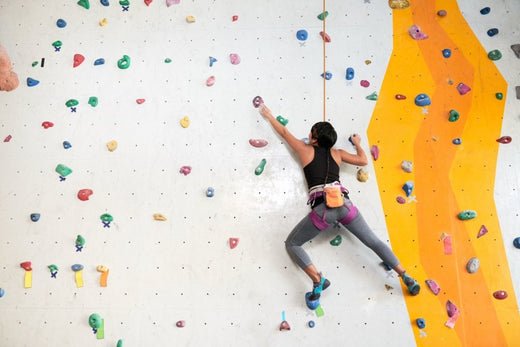Do you think climbing a rock wall is a piece of cake? Well, you can say it for professionals who have been doing it for years, but it’s one heck of a task for beginners.
Even with all the guidance and mentorship, it is certain that they will make some rock climbing mistakes.
Therefore, the following is a detailed explanation of the rock climbing beginner mistakes to avoid:
1. No Warm Up

Not warming up before starting a climbing session is a common beginner rock climbing mistake. It is recommended to warm your body up so you can prevent a possibility of an injury to take your climbing game to the next level.
Once your body has warmed up, you have given it enough time to begin circulating blood throughout the muscles, allowing them to stretch further.
It is obvious that the climber can hold longer onto more weight when the muscles are compressed more tightly.
The main advantage of warming up before climbing a rock or even a wall is that it allows you to attempt harder routes without becoming overly exhausted.
Of course, as a beginner climber, you should focus on the simpler routes, but make it a habit to warm up so that when you have to choose the more difficult climbing routes, you can ace them easily.
2. Ignoring Safety Measures

The worst thing you can do if you are a beginner at rock climbing is to disregard your safety precautions because you run the risk of falling at any time during your climbing session.
Make sure you always use premium quality liquid chalk so your hands don’t sweat a lot and you can have a string climbing grip.
Wearing a helmet is necessary so that your skull won't sustain any injury if you fall from a certain height.
One of the top rock climbing mistakes is that beginners try to climb by rappelling, and that’s not right. Always give your best and try descending a climb on your feet.
When climbing with a single pitch or top rope, tie a knot to the end of the rope opposite the climber (the dead end). When climbing with multiple pitches, ensure that the climber and the belayer are tied to the rope. If the rope is too short for a particular pitch, this prevents the end of the rope from sliding through the belay device.
3. Climbing With Bent Or Strained Arms

It doesn’t matter how passionate you are about climbing; you won’t be able to survive in this domain if you go for a session with bent or strained arms.
If you go there with crooked or tense arms, you will start feeling exhausted in the middle of climbing, which will be an embarrassment.
You should keep your arms straight and your weight slacks to apply natural pressure to the handholds as you move up the wall.
Trying a position that lets you alternately stretch out your arms and shake them can be helpful when fatigued.
4. Only Looking Upwards

Another beginner rock climbing mistake is only looking up while climbing a wall or a rock.
It is much better to keep an eye on your feet to find useful resting positions and to ensure pro-level footwork than to search for your next handhold.
So, what should a new climber do to eliminate this climbing mistake?
While you are climbing, imagine that there is a halo encircling your body that is between five and seven feet in diameter. Focus on the handholds ahead of you, but also pay attention to your feet and the options to your sides.
Looking at your feet is one of the best rock climbing tips for beginners to ensure a safe climbing session.
5. Poor Hip Technique

When beginning, climbing a rock wall with your feet forward, butt out, and your hips aligned with the wall is common.
However, it is best to keep your hips close to the wall when you climb. This is the most natural and suitable climbing position for new climbers.
By placing your left hip against the wall and primarily using your left foot, you will be able to reach farther than you would if your hips were square or inverted.
So, better pay attention to your hip technique to enjoy all the benefits of rock climbing.
Final Remarks
The aforementioned are the most dangerous climbing mistakes to avoid for beginners because, with these mistakes and errors, they won’t be able to excel.
During your rock climbing career, what are some other mistakes you’ve made?
Or, if you know about some other rock climbing mistakes to avoid, share them with us in the comments section.
FAQs
How should a beginner start climbing?
Discovering a club, a willing friend, or a qualified instructor is the simplest way to get started. Rock climbing can be started both indoors and outdoors, though many people today seem to begin at their local climbing wall. You should begin by seconding or top roping and work your way up to leading routes.
How long should a climbing session be for beginners?
The same rule applies to the length of a bouldering session as it does to a typical gym session. Depending on how hard you train and how often you boulder, a session for a beginner can last anywhere from 60 minutes to 4-5 hours.
Why do climbers not wear gloves?
Gloves may keep your skin safe, but they also make it difficult for you to feel the holds clearly. Feeling the friction and the finer details of the holds will help you "stick" to them more effectively when climbing. Your skin will initially hurt, but as time passes, it will toughen up and form tiny calluses, making the pain go away.



